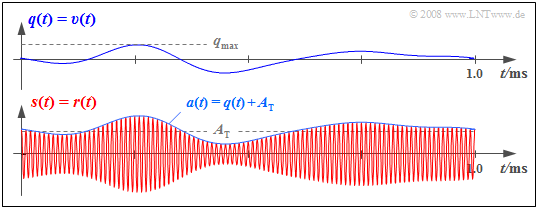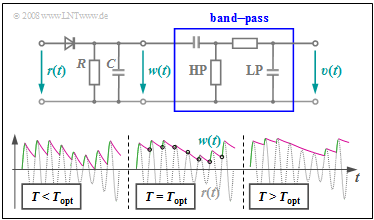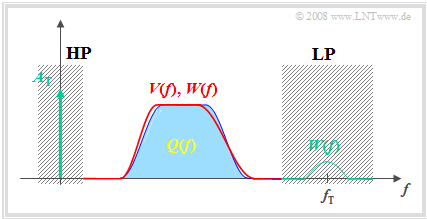Difference between revisions of "Modulation Methods/Envelope Demodulation"
Tag: Undo |
m |
||
| Line 90: | Line 90: | ||
:Here, an ideal demodulation is possible with an envelope demodulator ⇒ $v(t) = q(t)$, if we ignore unavoidable noise. | :Here, an ideal demodulation is possible with an envelope demodulator ⇒ $v(t) = q(t)$, if we ignore unavoidable noise. | ||
* In contrast, when $m > 1$ , the following relationship holds: | * In contrast, when $m > 1$ , the following relationship holds: | ||
| − | :$$a(t) = | + | :$$a(t) = \vert q(t) + A_{\rm T} \vert \hspace{0.05cm}.$$ |
:*Here, envelope demodulation always leads to [[Linear_and_Time_Invariant_Systems/Nonlinear_Distortions|nonlinear distortions]]. | :*Here, envelope demodulation always leads to [[Linear_and_Time_Invariant_Systems/Nonlinear_Distortions|nonlinear distortions]]. | ||
:*The sink signal $v(t)$ now includes new frequencies, which were not present in $q(t)$ . | :*The sink signal $v(t)$ now includes new frequencies, which were not present in $q(t)$ . | ||
Revision as of 18:22, 5 December 2021
Contents
Functionality under ideal conditions
Wie first assume the following conditions:
- Let the source signal $q(t)$ be free of a DC component and limited in magnitude to $q_{\rm max}$ .
- The transmission is based on the modulation method „DSB–AM with carrier”.
- For simplicity of representation, the carrier phase is set to $\mathbf{ϕ_{\rm T} } = 0$ without restricting generality:
- $$s(t) = \left(q(t) + A_{\rm T}\right) \cdot \cos (\omega_{\rm T}\cdot t )\hspace{0.05cm}.$$
- Let the modulation depth be $m ≤ 1$. Therefore, from the definition $m = q_{\rm max}/A_{\rm T}$ it also follows that $q(t) + A_{\rm T} ≥ 0$.
- Let the channel be ideal, that is, there is no distortion, no attenuation, no delay, and no (noise) interference.
- Thus, when $H_{\rm K}(f) = 1$ and $n(t) \equiv 0$ we get
- $$r(t) = s(t) = a(t) \cdot \cos (\omega_{\rm T}\cdot t )\hspace{0.05cm}$$
- for the received signal.
- In this equation, $a(t)$ describes the envelope of $r(t)$. The phase function is $\mathbf{ϕ}(t) = 0$.
$\text{Definition:}$ An envelope demodulator detects the envelope $a(t)$ of its input signal $r(t)$ and outputs it as a sink signal after eliminating the DC component $A_{\rm T}$ :
- $$v(t) = a(t) - A_{\rm T}\hspace{0.05cm}.$$
The removal of the DC component $A_{\rm T}$ can be realized, for example, by a high-pass filter that allows all frequencies to pass unimpeded except for $f = 0$ .}
- If all the above conditions are met, then $v(t) = q(t)$ holds.
- This means that an ideal message communication system can certainly be realized with an (ideal) envelope demodulator.
$\text{Example 1:}$ In the graph, the received signal $r(t) = s(t)$ is shown below, and is based on "DSB–AM with carrier” $($modulation depth $m = 0.5)$.
- The envelope $a(t)$ to be evaluated by the envelope demodulator is equal to the sum of the source signal $q(t)$ and the DC component $A_{\rm T}$ added at the transmitter.
- $v(t) = q(t)$ holds for the demodulator output signal after removing the DC component $A_{\rm T}$ with a high-pass filter, assuming that the source signal $q(t)$ did not include a DC component. Such a component would (wrongly) also be removed by the high-pass filter.
Realizing an envelope demodulator
The adjacent graph shows:
- above, a simple possible realization of the envelope demodulator above,
- below, the signals $r(t)$ and $w(t)$ to illustrate the principle.
First, consider the middle signal section denoted by $T = T_{\rm opt}$ .
The first circuit section – consisting of a diode and a parallel connection of a resistor $R$ and a capacitance $C$ – performs the following tasks:
- If the (light) grey signal $r(t)$ is larger than the voltage $r(t)$ at $R$ and $C$, the diode conducts, $w(t) = r(t)$ holds, and the capacitance $C$ is charged. In these regions, the signal $w(t)$ is drawn in green.
- If $r(t) < w(t)$ , as it does at the times marked in purple, the diode blocks and the capacitance discharges through resistor $R$. The signal $w(t)$ decays exponentially with time constant $T = R · C$ .
- From the times marked with circles, $r(t) > w(t)$ holds again and the capacitance is recharged. It can be seen from the sketch that $w(t)$ "approximately" matches the envelope $a(t)$ .
$\text{Design criteria:}$
- The deviations between the envelope approximation $w(t)$ and its nominal function $a(t)$ decrease the larger the carrier frequency $f_{\rm T}$ is compared to the bandwidth $B_{\rm NF}$ of the low frequency message signal. As a guideline, $f_{\rm T} ≥ 100 · B_{\rm NF}$ is often given.
- At the same time, the time constant $T$ of the RC –parallel resonant circuit should always be much larger than $1/f_{\rm T}$ and much smaller than $1/B_{\rm NF}$ . A good compromise is the geometric mean between the two limits:
- $$1/f_{\rm T}\hspace{0.1cm} \ll \hspace{0.1cm} T \hspace{0.1cm} \ll \hspace{0.1cm} 1/B_{\rm NF} \hspace{0.05cm}, \hspace{2cm} T_{\rm opt} = {1}/{\sqrt{f_{\rm T} \cdot B_{\rm NF} } } \hspace{0.05cm}.$$
- If the time constant $T$ is too small, as in the left area of the sketch above, the capacitor will always discharge too quickly and the deviation $w(t) \ – \ a(t)$ will be unnecessarily large.
- Also, too large a value $T > T_{\rm opt}$ will result in deterioration, as shown in the right signal detail. In this case, $w(t)$ can no longer follow the envelope $a(t)$ .
$\text{Example 2:}$ For a LF-bandwidth of $5 \ \rm kHz$ , the carrier frequency should be at least $500 \ \rm kHz$ .
- The time constant $T$ must be much larger than $1/f_{\rm T} = 2 \ \rm µ s$ and at the same time much smaller than $1/B_{\rm NF} = 200 \ \rm µ s $.
- The optimal value according to the compromise formula is thus:
- $$T_{\rm opt} = 1/\sqrt{ 5 \cdot 10^5 \ {\rm Hz} \cdot 5 \cdot 10^3 \ {\rm Hz} } = 20 \ \rm µ s \hspace{0.05cm}.$$
The graph on the right is intended to illustrate the operation of the envelope demodulator in the frequency domain. The spectrum $W(f)$ of the signal $w(t)$ at the RC parallel circuit differs from the spectrum $Q(f)$ of the source signal as follows:
- Due to the carrier signal $z(t)$ added at the transmitter, the spectral function $W(f)$ includes a Dirac line at $f = 0$ with weight $A_{\rm T}$ (carrier amplitude).
- $W(f)$ also exhibits spectral components in the region around the carrier frequency $f_{\rm T}$ , which can be explained by the jagged time course of $w(t)$ (see the first graph in this section).
- $W(f)$ also differs only slightly from $Q(f)$ in the LF domain. Here, the error gets smaller as the carrier frequency increases compared to the AF bandwidth.
The first two signal distortions are eliminated by the high-pass and low-pass filters, which together produce a bandpass. However, there also remains a slight deviation between the sink signal $v(t)$ and the source signal $q(t)$ in the interesting range $0 < f < B_{\rm NF}$ , as shown by comparing the output spectrum $V(f)$ plotted in red and the input spectrum $Q(f)$ plotted in blue.
Why envelope demodulation fails for $m > 1$
The graph shows the DSB-AM signals for $m = 0.5$ and $m = 2$.
From this picture one can recognise the following differences:
- For a modulation depth $m ≤ 1$ the envelope of the bandpass signal is characterised by:
- $$a(t) = q(t) + A_{\rm T}\hspace{0.05cm}.$$
- Here, an ideal demodulation is possible with an envelope demodulator ⇒ $v(t) = q(t)$, if we ignore unavoidable noise.
- In contrast, when $m > 1$ , the following relationship holds:
- $$a(t) = \vert q(t) + A_{\rm T} \vert \hspace{0.05cm}.$$
- Here, envelope demodulation always leads to nonlinear distortions.
- The sink signal $v(t)$ now includes new frequencies, which were not present in $q(t)$ .
- For the DC component(expected value) of the envelope der Hüllkurve gilt in diesem Fall:
- $${\rm E}[a(t)] \ne A_{\rm T}\hspace{0.05cm}.$$
- Da nun anstelle von $A_{\rm T}$ dieser Gleichanteil ${\rm E}[a(t)]$ durch den Hochpass entfernt wird, kommt es zusätzlich zu einer Pegelverschiebung.
Description using the equivalent low-pass signal
Insbesondere dann, wenn das Quellensignal $q(t)$ als Summe mehrerer harmonischer Schwingungen dargestellt werden kann, ist eine Signalbeschreibung mit dem äquivalenten Tiefpass–Signal ${
<div style="clear:both;">
</div>
</div> = 0.102\hspace{0.3cm}K_3 ={|A_{\rm 3}|}/{A_{\rm 1}} = 0.082,\hspace{0.3cm}K_4 = {|A_{\rm 4}|}/{A_{\rm 1}} = 0.058,\hspace{0.1cm}\text{...}'"`UNIQ-MathJax9-QINU`"'\Rightarrow \hspace{0.3cm}K = \sqrt{K_2^2 + K_3^2 + K_4^2 +\text{...} } \approx 15 \%.'"`UNIQ-MathJax10-QINU`"'R_{\rm TP}(f) \hspace{-0.05cm}=\hspace{-0.05cm} S_{\rm TP}(f) \hspace{0.02cm}, \hspace{0.15cm}
r_{\rm TP}(t) \hspace{-0.05cm}=\hspace{-0.05cm} s_{\rm TP}(t) \hspace{0.02cm}, \hspace{0.15cm}
r(t) \hspace{-0.05cm}=\hspace{-0.05cm} s(t) \hspace{0.02cm}.'"`UNIQ-MathJax11-QINU`"'v(t) = A_{\rm 1} \cdot \cos(\omega_{\rm N}\cdot t ) +A_{\rm 2} \cdot \cos(2\omega_{\rm N}\cdot t
)+A_{\rm 3} \cdot \cos(3\omega_{\rm N} \cdot t )+ \text{...}'"`UNIQ-MathJax12-QINU`"'H_{\rm K} (f = f_{\rm T})= \alpha_0, \hspace{0.3cm} H_{\rm K} (f
= \pm f_{\rm 1})= \alpha_1, \hspace{0.3cm}H_{\rm K} (f = \pm
f_{\rm 2})= \alpha_2;'"`UNIQ-MathJax13-QINU`"'v(t) = \alpha_1 \cdot A_{\rm 1} \cdot \cos(2 \pi f_{\rm 1} t ) +
\alpha_2 \cdot A_{\rm 2} \cdot \cos(2 \pi f_{\rm 2} t ) \hspace{0.05cm}.'"`UNIQ-MathJax14-QINU`"'10 \cdot {\rm lg }\hspace{0.1cm} \xi = 10 \cdot {\rm lg }\hspace{0.1cm} \frac{\alpha_{\rm K}^2 \cdot P_{\rm S}}{N_0 \cdot B_{\rm NF}} \hspace{0.05cm}.$$
Das Ergebnis des Hüllkurvendemodulators ist mit durchgezogenen Linien markiert, während die gestrichelten Geraden den Synchrondemodulator kennzeichnen.
Wie bereits in Kapitel [[Modulation_Methods/Qualitätskriterien#Untersuchungen_im_Hinblick_auf_Signalverzerrungen|Untersuchungen im Hinblick auf Signalverzerrungen]] hergeleitet wurde, ergeben sich für den Synchrondemodulator in dieser doppelt–logarithmischen Darstellung
*die Winkelhalbierende (für $m → ∞$, ZSB–AM ohne Träger), bzw.
*hierzu parallel verschobene Gerade mit vertikalem Abstand $10 · \lg \, (1 + 2/m^2$).
Bei Anwendung von Hüllkurvendemodulation sind folgende Unterschiede festzustellen:
*Ein Hüllkurvendemodulator ist für $m > 1$ nicht sinnvoll, da dadurch starke nichtlineare Verzerrungen entstehen würden.
*Die durchgehend gezeichneten Kurven für den Hüllkurvendemodulator $\rm (HKD)$ liegen stets unterhalb der für den Synchrondemodulator $\rm (SD)$ gültigen gestrichelten Geraden, wenn man vom gleichen Modulationsgrad $m$ ausgeht.
*Ab einem gewissen Wert der Leistungskenngröße $ξ$ sind die $\rm HKD$–Kurven von den $\rm SD$–Geraden innerhalb der Zeichengenauigkeit nicht mehr zu unterscheiden.
Mehr Informationen zu dieser Thematik finden Sie beispielsweise in [Kam 04]'"`UNIQ--ref-00000008-QINU`"'.
=='"`UNIQ--h-4--QINU`"'Argumente für und gegen den Hüllkurvendemodulator==
<br>
Der wichtigste Grund für die Verwendung des Hüllkurvendemodulators ist (besser gesagt: war), dass damit die oft aufwändige Frequenz– und Phasensynchronisation vermieden wurde, so dass dieser preisgünstig realisiert werden konnte. Der Hüllkurvendemodulator ist somit ein Beispiel eines ''inkohärenten Demodulators''.
Für den [[Modulation_Methods/Synchrondemodulation|Synchrondemodulator]] und gegen den Hüllkurvendemodulator können dagegen mehrere Gründe angeführt werden:
*Bei Hüllkurvendemodulation muss eine Übermodulation $(m > 1)$ unter allen Umständen vermieden werden. Dies erreicht man beispielsweise durch die Amplitudenbegrenzung des Quellensignals, was aber ebenfalls nichtlineare Verzerrungen zur Folge hat.
*Bei sonst gleichen Randbedingungen ist ein Modulationsgrad $m < 1$ nur durch die Erhöhung der Sendeleistung um mindestens den Faktor $3$ zu erreichen. Dies ist auch wegen der berechtigten Diskussionen zum Thema „Elektro-Smog” in großen Teilen unserer Gesellschaft problematisch.
- Lineare Kanalverzerrungen können bei einem Hüllkurvendemodulator zu irreversiblen nichtlinearen Verzerrungen führen, während die bei Synchrondemodulation entstehenden linearen Verzerrungen möglicherweise durch besondere Maßnahmen beim Empfänger kompensiert werden können.
Aufgaben zum Kapitel
Aufgabe 2.7: Ist der Modulationsgrad zu groß?
Aufgabe 2.7Z: ZSB-AM und Hüllkurvendemodulator
Aufgabe 2.8: Unsymmetrischer Kanal
Aufgabe 2.9: Symmetrische Verzerrungen
Quellenverzeichnis
- ↑ Kammeyer, K.D.: Nachrichtenübertragung. Stuttgart: B.G. Teubner, 4. Auflage, 2004.



